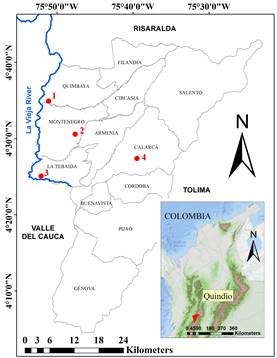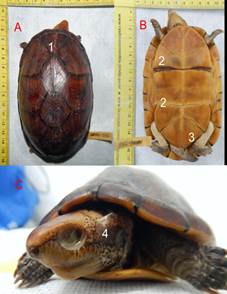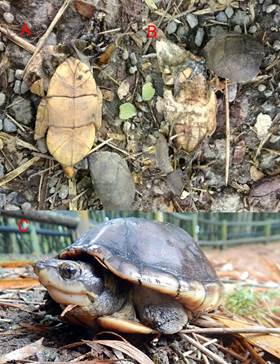Introduction
Kinosternon leucostomum (DUMÉRIL and BIBRON, 1851) is a species of the Kinosternidae family, and currently has two described subspecies K. l. leucostomum (DUMÉRIL and BIBRON, 1851) which is distributed along Mexico (Veracruz), also present in Belize, Guatemala, Honduras and Nicaragua; and K. l. postinguinale (COPE, 1887), distributed from the borders of Nicaragua and Costa Rica, through Colombia, until south of the Ecuadorian Pacific (GIRALDO et al., 2013; TURTLE TAXONOMY WORKING GROUP, 2017). In Colombia, the subspecies K. l. postinguinale, occurs in the departments of Antioquia, Atlántico, Bolívar, Boyacá, Caldas, Cauca, Cesar, Chocó, Córdoba, Cundinamarca, Guajira, Magdalena, Nariño, Santander, Sucre, Tolima and Valle del Cauca. These departments correspond to the Caribbean, Magdalena and Pacific basins (GIRALDO et al., 2013; MENDOZA and ROPAIN, 2017).
Kinosternon leucostomum, better known as the White-Lipped Mud Turtle is one of the smallest South American chelonians, reaching maximum sizes of 17 cm of straight carapace length (SCL). It presents nocturnal activity, although it can be found active in the day; and is usually found in freshwater ecosystems such as rivers, creeks, wetlands and ponds; but also on mainland. It is an omnivorous species and feeds on fish, invertebrates and sometimes plants (RUEDA-ALMONACID et al., 2007; CEBALLOS et al., 2016). Its reproduction extends throughout the year, and they lay between one and six eggs per nest (GIRALDO et al., 2013). Although the subspecies K. l. postinguinale is one of the most common turtles in some regions of Colombia, human disturbances such as fragmentation of forests, drying of wetlands, water pollution, in addition to their consumption of meat and their use as pets, can promote decrease in population (CORREDOR-L et al., 2007; RUEDA-ALMONACID et al., 2007; GIRALDO et al., 2013; MORALES-BETANCOURT et al., 2015). Currently, its conservation status has not been assessed globally by IUCN, neither is listed in any appendix of CITES 2017. However, it is considered as Least Concern according to the Red Book of Colombian Reptiles (MORALES-BETANCOURT et al., 2015).
Between May to late September of 2017, we recorded the distribution of K. l. postinguinale in the lower and middle area of La Vieja basin in the Department of Quindío (900-1500 m.a.s.l), we found 61 individuals, 44 in Cajones creek 04°32'19.11" N, 075°46'7.93" W; Seven in Vereda La Palmita, Valle de Pisamal 04°24'53.05" N, 075°52'34.43" W; and Ten in The Natural Reserve Montaña del Ocaso 04°34'46.98" N, 075°51'52.95" W (Figure 1, Table 1). Individuals were captured, measured and marked in their marginal scutes of their carapace (CAGLE, 1939) and the localities were georeferenced, but no turtles were collected. To determine the taxonomic level of the species, we used a previously collected specimen from the municipality of Calarcá (04°30'44.70" N, 075°39'6.13" W) (ARUQ-232) (Figure 2).

Figure 1 Sites with the presence of Kinosternon leucostomum postinginale individuals in Quindío, Colombia. Red dots show localities: 1 = Montaña del Ocaso, 2 = Cajones creek, 3 = La Palmita, 4 = Municipality of Calarcá.
Table 1 Mean values of size and weight of males, females and juveniles of Kinosternon leucostomum postinguinale, observed in the study localities.
| Number of turtles | Variable | Mean | Min. Value | Max. Value |
|---|---|---|---|---|
| Cajones creek | ||||
| 18 Males | SCL (cm) | 11,94 | 9,53 | 14,19 |
| Weight (gr) | 233,11 | 107,72 | 391,2 | |
| 23 Females | SCL (cm) | 11,76 | 9,15 | 13,66 |
| WEIGHT (gr) | 228,71 | 90,7 | 374,2 | |
| 3 Juveniles | SCL (cm) | 6,99 | 5,09 | 8,94 |
| Weight (gr) | 51,93 | 17 | 93,5 | |
| La Palmita | ||||
| 3 Males | SCL (cm) | 13,27 | 12,35 | 14,11 |
| Weight (gr) | 314,33 | 269 | 374 | |
| 4 Females | SCL (cm) | 11,82 | 10,04 | 12,82 |
| Weight (gr) | 259,63 | 223,9 | 314,6 | |
| El Ocaso | ||||
| 6 Males | SCL (cm) | 12,51 | 9,66 | 13,94 |
| Weight (gr) | 268,18 | 104,8 | 374,2 | |
| 4 Females | SCL (cm) | 12,89 | 10,83 | 14,43 |
| Weight (gr) | 299,75 | 141,7 | 416,7 | |
Note: SCL = Straight Carapace Length.

Figure 2 Kinosternon leucostomum postinguinale specimen in the Amphibian and Reptile Collection of the University of Quindío (ARUQ-232), collected in the municipality of Calarcá, Quindío A. Dark brown smooth shell, (1) Vertebral shield one in contact with marginal 2. B. low-cut and broad plastron that almost completely covers the carapace openings, (2) hinges; (3) anal notch almost absent. C. Detail of the head in lateral view, characteristic cream color lips (4) postorbital ribbon covered with yellow and brown spots.
The individuals of K. l. postinguinale reported in this work has been identified by the following external morphological characters: adult individuals show a smooth, bulging and oblong shell, which generally is in a dark brown coloration, however, it can vary among localities, being in some others light-brown and yellowish-brown carapaces (Figure 2 A) (BERRY and IVERSON, 2001; GIRALDO et al., 2013). Plastron shows a yellowish-brown coloration, whit dark seams and it has notches into anal scutes; plastron is relatively wide and because the previous and later lobes are mobiles, completely covers the shell (Figure 2 B) (RUEDA-ALMONACID et al., 2007; GIRALDO et al., 2013). Dark brown head on the back and yellowish on the ventral side, including the jaws that are cream colored. Yellow postorbital broad strip on each side of the neck, which tends to be lost in adults, where it is replaced by a mixture of yellow and brown pits (Figure 2 C) (BERRY and IVERSON, 2001; GIRALDO et al., 2013).
The presence of K. l. postinguinale in the department of Quindío has not been included in the distribution of the species in Colombia (RUEDA-ALMONACID et al., 2007; PÁEZ et al., 2012; TURTLE TAXONOMY WORKING GROUP, 2017). However, BENÍTEZ-CUBILLOS and ARANGO-LOZANO (2015) recorded its use as pet in the department. The only turtle species previously recorded for this Andean locality is the South American Snapping Turtle (Chelydra acutirostris) which occupies the entire middle and lower area of the La Vieja basin (ARANGO-LOZANO et al., 2017). In this work, we evidenced that K. l. postinguinale inhabits in pastures, possibly searching for ponds, a behavior already documented for this species (RUEDA-ALMONACID et al., 2007; GIRALDO et al., 2013). It was also found in secondary roads, where we observed individuals that were possibly ran over by vehicles (Figure 3 A, B), and in low-flow primary type streams and in wetlands associated with watercourses. Seven captured individuals of K. l. postinguinale had mutilated limbs (Figure 3 C), possibly due to interactions with other medium vertebrates, such as Lontra longicaudis and Chelydra acutirostris, both predators recognized in the area of La Vieja basin (BOTERO-BOTERO et al., 2016; YOUNG-VALENCIA et al., 2017; ARANGO-LOZANO et al., 2017), and also, by interaction with terrestrial predators.

Figure 3 A, B. Remains (carapace and plastron) of Kinosternon Leucostomum postinguinale in a secondary road of Vereda La Palmita, in the municipality of La Tebaida, Quindío. C. individual of Kinosternon Leucostomum postinguinale with a left upper limb mutilation; Cajones creek, Montenegro, Quindío.
In the amphibian and reptile collection of the University of Quindío, it is stored from 2012 the only K. l. postinguinale specimen collected (Voucher: ARUQ-232) (Figure 2). It’s a male captured in the municipality of Calarcá 04°30'44.70" N, 075°39'6.13" W, prior to this, there is no evidence of the turtle in department of Quindío.














